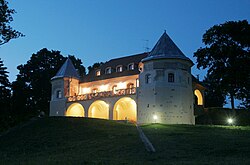
This article is about the administrative divisions of Lithuania.

Eišiškės is a small city in southeastern Lithuania on the border with Belarus. It is situated on a small group of hills, surrounded by marshy valley of Verseka and Dumblė Rivers. The rivers divide the town into two parts; the northern part is called Jurzdika. As of the census in 2011, Eišiškės had a population of 3,416. It has a hospital and two high schools.

The Treaty of Melno or Treaty of Lake Melno was a peace treaty ending the Gollub War. It was signed on 27 September 1422, between the Teutonic Knights and an alliance of the Kingdom of Poland and the Grand Duchy of Lithuania at Lake Melno, east of Graudenz (Grudziądz). The treaty resolved territorial disputes between the Knights and Lithuania regarding Lithuania Minor and Samogitia, which had dragged on since 1382, and determined the Prussian–Lithuanian border, which afterwards remained unchanged for about 500 years. A portion of the original border survives as a portion of the modern border between the Republic of Lithuania and Kaliningrad Oblast, Russia, making it one of the oldest and most stable borders in Europe.
Ežerėlis is a city in Kaunas County, Lithuania. It is located 15 km (9.3 mi) west of Kaunas city municipality. It is a fairly new settlement as it started developing only in 1918 when a peat digging enterprise was established in the Ežerėlis Bog. According to the census of 1923, it had 132 residents. In 1959 the town reached the population of 2,200 and remained fairly stable since then.

Upninkai is the largest village in Jonava district, Lithuania. It is situated 8 km southwest of Vepriai on the left bank of the Šventoji River. According to the 2011 census, it had population of 786.
Stanislovas Kęstgaila (1503–1532) was a Lithuanian nobleman, son of Stanislovas Kęsgaila from the Kęsgailos family. Stanislovas Kęstgaila was the Elder of Samogitia (1527–1532) and castellan of Trakai (1528–1532). After marriage to Anna, daughter of Stanisław Kiszka, Stanislovas was the wealthiest magnate in the Grand Duchy of Lithuania.

The House of Alšėniškiai was a Lithuanian princely family of Hipocentaur coat of arms. Their patrimony was the Principality of Alšėnai, which included the castles of Rokantiškės and Alšėnai.
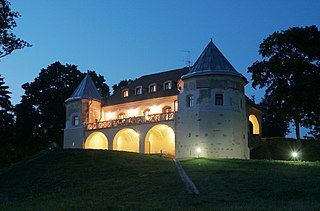
Norviliškės Castle is a Renaissance style castle in Norviliškės, Lithuania. The Norviliškės Castle is first mentioned in 1586. In 1617 the owners donated part of the real estate land to Franciscans. Around 1745 they built a monastery and a church in Renaissance style. The monastery was reconstructed at the end of the 18th century by Kazimieras Kaminskis. After the November Uprising of 1831, Russian authorities closed the monastery and turned it into barracks for soldiers, and later to a boarding school for girls. The Church of St. Mary Compassionate Mother was closed at the same time as the monastery. A new wooden church was built in 1929.

Turmantas is a town in the Zarasai district municipality, Lithuania. Located on the border with Latvia, it is a railway station on the Warsaw – Saint Petersburg railway. The village is known since 1798. It began growing after completion of the railway in 1862. As part of the Wilno Voivodeship, Turmantas was part of the Second Polish Republic between 1920 and 1939. During that time a wooden Catholic church was rebuilt, an Orthodox church for the Old Believers and a secondary school were built in the town. According to the 2011 census, it had 286 residents.
The Lithuanian Chronicles are three redactions of chronicles compiled in the Grand Duchy of Lithuania. All redactions were written in the Ruthenian language and served the needs of Lithuanian patriotism. The first edition, compiled in the 1420s, glorified Vytautas the Great and supported his side in power struggles. The second redaction, prepared in the first half of the 16th century, started the myth of Lithuanian Roman origin: it gave a fanciful genealogy of Palemon, a noble from the Roman Empire who founded the Grand Duchy. This noble origin of Lithuanians was important in cultural rivalry with the Kingdom of Poland. The third redaction, known as the Bychowiec Chronicle, elaborated even further on the legend, but also provided some useful information about the second half of the 15th century. The three redactions, the first known historical accounts produced within the Grand Duchy, gave rise to the historiography of Lithuania. All medieval historians used these accounts, that survived in over 30 known manuscripts, as basis for their publications and some of the myths created in the chronicles persisted even to the beginning of the 20th century.
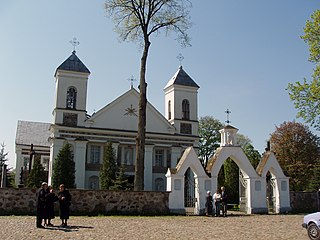
Valkininkai is a historic town in Valkininkų (Valkininkai) eldership, Varėna District Municipality, Alytus County, Lithuania, located about 22 km (14 mi) northeast from Varėna and about 55 km (34 mi) southwest from Vilnius. At the Lithuanian census of 2001, its population was 238 and at the census of 2011 it was 229.
Ritterswerder was a short-lived wooden castle built by the Teutonic Order in fall 1391. It was located on an island in the Neman River near Lampėdžiai, now part of the city of Kaunas.

Šventežeris is a small town in Alytus County in southern Lithuania. As of 2011 it had a population of 295. It is situated some 8 kilometres (5.0 mi) east of Lazdijai on the banks of Lake Šventežeris.
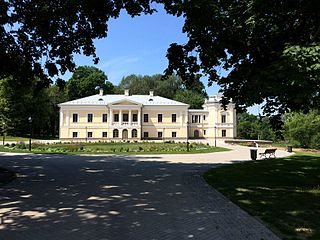
Jašiūnai is a town in Lithuania. It is situated on the Merkys River and an edge of the Rūdninkai Forest. According to the 2001 census, it had population of 1,879. The town's population is primarily Poles, with Lithuanians (12,4%) and Russians (8,4%).
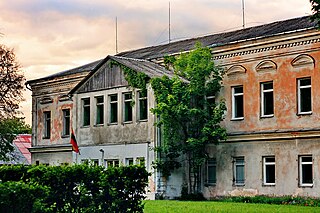
Buivydiškės is a village in Vilnius district municipality, Lithuania. According to the 2011 census, it had 1,314 residents. Buivydiškės Manor was first mentioned in 1593. The village has a technical school for agronomy and zootechnics, established in 1961. The school helped the village to grow from 190 residents in 1959 to 1,265 in 1970. Buivydiškės became a suburb of expanding Vilnius, capital of Lithuania. In 1996, part of the settlement was transferred to Vilnius city municipality.

Puntukas is the second-largest boulder in Lithuania, a natural monument of the state. It is situated some 5 kilometres (3.1 mi) south of Anykščiai on the left bank of the Šventoji River. It was believed to be the largest stone in Lithuania until the discovery of Barstyčiai stone in the Skuodas district in 1957.
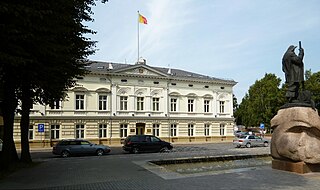
The Parliament of the Klaipėda Region was the parliament of the Klaipėda Region, an autonomous region of Lithuania. The parliament was established by the Klaipėda Convention of 1924 and the first elections took place in October 1925.
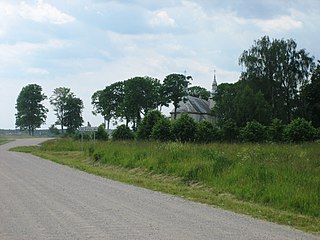
Šešuoliai is a small town in central Lithuania. It is located just east of the Lake Šešuoliai. According to the Lithuanian census of 2011, it had 138 residents. The town's central square and street layout is protected as an urban monument.
The Lithuanian Conservative Election Societies were several loosely connected political societies of Prussian Lithuanians active from 1890 to the German Revolution of 1918–19. They sought to elect Prussian Lithuanians to the German Reichstag and Prussian Landtag and to defend the use of the Lithuanian language. The societies managed to get two representatives to the Reichstag and two to the Landtag. It is sometimes described as the first Lithuanian political party.
Dovas Zaunius (1845–1921) was a Prussian Lithuanian cultural and political activist.
